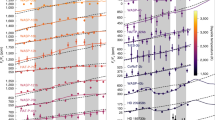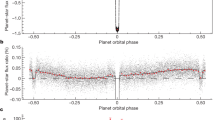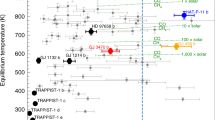Abstract
Thousands of transiting exoplanets have been discovered, but spectral analysis of their atmospheres has so far been dominated by a small number of exoplanets and data spanning relatively narrow wavelength ranges (such as 1.1–1.7 micrometres). Recent studies show that some hot-Jupiter exoplanets have much weaker water absorption features in their near-infrared spectra than predicted1,2,3,4,5. The low amplitude of water signatures could be explained by very low water abundances6,7,8, which may be a sign that water was depleted in the protoplanetary disk at the planet’s formation location9, but it is unclear whether this level of depletion can actually occur. Alternatively, these weak signals could be the result of obscuration by clouds or hazes1,2,3,4, as found in some optical spectra3,4,10,11. Here we report results from a comparative study of ten hot Jupiters covering the wavelength range 0.3–5 micrometres, which allows us to resolve both the optical scattering and infrared molecular absorption spectroscopically. Our results reveal a diverse group of hot Jupiters that exhibit a continuum from clear to cloudy atmospheres. We find that the difference between the planetary radius measured at optical and infrared wavelengths is an effective metric for distinguishing different atmosphere types. The difference correlates with the spectral strength of water, so that strong water absorption lines are seen in clear-atmosphere planets and the weakest features are associated with clouds and hazes. This result strongly suggests that primordial water depletion during formation is unlikely and that clouds and hazes are the cause of weaker spectral signatures.
This is a preview of subscription content, access via your institution
Access options
Subscribe to this journal
Receive 51 print issues and online access
$199.00 per year
only $3.90 per issue
Buy this article
- Purchase on Springer Link
- Instant access to full article PDF
Prices may be subject to local taxes which are calculated during checkout



Similar content being viewed by others
References
Deming, D. et al. Infrared transmission spectroscopy of the exoplanets HD 209458b and XO-1b using the Wide Field Camera-3 on the Hubble Space Telescope . Astrophys. J. 774, 95 (2013)
Line, M. R. et al. A near-infrared transmission spectrum for the warm Saturn Hat-P-12b. Astrophys. J. 778, 183 (2013)
Sing, D. K. et al. HST hot-Jupiter transmission spectral survey: evidence for aerosols and lack of TiO in the atmosphere of WASP-12b. Mon. Not. R. Astron. Soc. 436, 2956–2973 (2013)
Sing, D. K. et al. HST hot-Jupiter transmission spectral survey: detection of potassium in WASP-31b along with a cloud deck and Rayleigh scattering. Mon. Not. R. Astron. Soc. 446, 2428–2443 (2015)
McCullough, P. R. et al. Water vapor in the spectrum of the extrasolar planet HD 189733b. I. The transit. Astrophys. J. 791, A55 (2014)
Madhusudhan, N. et al. H2O abundances in the atmospheres of three hot Jupiters. Astrophys. J. 791, L9 (2014)
Madhusudhan, N. et al. Toward chemical constraints on hot Jupiter migration. Astrophys. J. 794, L12 (2014)
Seager, S. et al. On the dayside thermal emission of hot Jupiters. Astrophys. J. 632, 1122–1131 (2005)
Öberg, K. I., Murray-Clay, R. & Bergin, E. A. The effects of snowlines on C/O in planetary atmospheres. Astrophys. J. 743, L16 (2011)
Pont, F. et al. The prevalence of dust on the exoplanet HD 189733b from Hubble and Spitzer observations. Mon. Not. R. Astron. Soc . 432, 2917–2944 (2013)
Nikolov, N. et al. HST hot-Jupiter transmission spectral survey: haze in the atmosphere of WASP-6b. Mon. Not. R. Astron. Soc. 447, 463–478 (2015)
Nikolov, N. et al. Hubble Space Telescope hot Jupiter transmission spectral survey: a detection of Na and strong optical absorption in HAT-P-1b. Mon. Not. R. Astron. Soc. 437, 46–66 (2014)
Wakeford, H. R. et al. HST hot Jupiter transmission spectral survey: detection of water in HAT-P-1b from WFC3 near-IR spatial scan observations. Mon. Not. R. Astron. Soc. 435, 3481–3493 (2013)
Huitson, C. M. et al. An HST optical to near-IR transmission spectrum of the hot Jupiter Wasp-19b: detection of atmospheric water and likely absence of TiO. Mon. Not. R. Astron. Soc. 434, 3252–3274 (2013)
Mandel, K. & Agol, E. Analytic light curves for planetary transit searches. Astrophys. J. 580, L171–L175 (2002)
Pont, F., Zucker, S. & Queloz, D. The effect of red noise on planetary transit detection. Mon. Not. R. Astron. Soc. 373, 231–242 (2006)
Fortney, J. J. et al. A unified theory for the atmospheres of the hot and very hot Jupiters: two classes of irradiated atmospheres. Astrophys. J. 678, 1419–1435 (2008)
Burrows, A. et al. Photometric and spectral signatures of three-dimensional models of transiting giant exoplanets. Astrophys. J. 719, 341–350 (2010)
Seager, S. & Sasselov, D. D. Theoretical transmission spectra during extrasolar giant planet transits. Astrophys. J. 537, 916–921 (2000)
Lodders, K. Jupiter formed with more tar than ice. Astrophys. J. 611, 587–597 (2004)
Mousis, O., Lunine, J. I., Madhusudhan, N. & Johnson, T. V. Nebular water depletion as the cause of Jupiter’s low oxygen abundance. Astrophys. J. 751, L7 (2012)
Wong, M. H. et al. Updated Galileo probe mass spectrometer measurements of carbon, oxygen, nitrogen, and sulfur on Jupiter. Icarus 171, 153–170 (2004)
Kreidberg, L. et al. Clouds in the atmosphere of the super-Earth GJ 1214b. Nature 505, 69–72 (2014)
Knutson, H. et al. Hubble Space Telescope near-IR transmission spectroscopy of the super-Earth HD 97658b. Astrophys. J. 794, A155 (2014)
Morley, C. V. et al. Neglected clouds in T and Y dwarf atmospheres. Astrophys. J. 756, 172 (2012)
Wakeford, H. R. & Sing, D. K. Transmission spectral properties of clouds for hot Jupiter exoplanets. Astron. Astrophys. 573, A122 (2015)
Showman, A. P. & Polvani, L. M. Equatorial superrotation on tidally locked exoplanets. Astrophys. J. 738, 71 (2011)
Oshagh, M. et al. Impact of occultations of stellar active regions on transmission spectra. Astron. Astrophys. 568, A99 (2014)
Burgasser, A. J. et al. Evidence of cloud disruption in the L/T dwarf transition. Astrophys. J. 571, L151–L154 (2002)
Cushing, M. C., Rayner, J. T. & Vacca, W. D. An infrared spectroscopic sequence of M, L, and T dwarfs. Astrophys. J. 623, 1115–1140 (2005)
Mandell, A. M. et al. Exoplanet transit spectroscopy using WFC3: WASP-12 b, WASP-17 b, and WASP-19 b. Astrophys. J. 779, 128 (2013)
Sing, D. K. et al. Stellar limb-darkening coefficients for CoRot and Kepler. Astron. Astrophys. 510, A21 (2010)
Hayek, W., Sing, D. K., Pont, F. & Asplund, M. Limb darkening laws for two exoplanet host stars derived from 3D stellar model atmospheres. Comparison with 1D models and HST light curve observations. Astron. Astrophys. 539, A102 (2012)
Schwarz, G. Estimating the dimension of a model. Ann. Stat. 6, 461–464 (1978)
Markwardt, C. B. Non-linear least squares fitting in IDL with MPFIT. Astron. Soc. Pacif. Conf. Ser . 411, 251–254 (2009)
Eastman, J., Gaudi, B. S. & Agol, E. EXOFAST: a fast exoplanetary fitting suite in IDL. Publ. Astron. Soc. Pacif . 125, 83–112 (2013)
Gibson, N. P. Reliable inference of exoplanet light-curve parameters using deterministic and stochastic systematics models. Mon. Not. R. Astron. Soc. 445, 3401–3414 (2014)
Evans, T. M. et al. A uniform analysis of HD 209458b Spitzer/IRAC lightcurves with Gaussian process models. Mon. Not. R. Astron. Soc. 451, 680–694 (2015)
Fortney, J. J. et al. Transmission spectra of three-dimensional hot Jupiter model atmospheres. Astrophys. J. 709, 1396–1406 (2010)
Lodders, K. Alkali element chemistry in cool dwarf atmospheres. Astrophys. J. 519, 793–801 (1999)
Lodders, K. & Fegley, B. Atmospheric chemistry in giant planets, brown dwarfs, and low-mass dwarf stars. I. Carbon, nitrogen, and oxygen. Icarus 155, 393–424 (2002)
Freedman, R. S., Marley, M. S. & Lodders, K. Line and mean opacities for ultracool dwarfs and extrasolar planets. Astrophys. J. 174 (Supp.), 504–513 (2008)
Visscher, C., Lodders, K. & Fegley, B. Jr. Atmospheric chemistry in giant planets, brown dwarfs, and low-mass dwarf stars. III. Iron, magnesium, and silicon. Astrophys. J. 716, 1060–1075 (2010)
Lecavelier des Etangs, A. et al. Rayleigh scattering in the transit spectrum of HD 189733b. Astron. Astrophys. 481, L83–L86 (2008)
Sing, D. K. et al. Hubble Space Telescope transmission spectroscopy of the exoplanet HD 189733b: high-altitude atmospheric haze in the optical and near-ultraviolet with STIS. Mon. Not. R. Astron. Soc. 416, 1443–1455 (2011)
Huitson, C. M. et al. Temperature–pressure profile of the hot Jupiter HD 189733b from HST sodium observations: detection of upper atmospheric heating. Mon. Not. R. Astron. Soc. 422, 2477–2488 (2012)
Vidal-Madjar, A. et al. The upper atmosphere of the exoplanet HD 209458 b revealed by the sodium D lines. Temperature-pressure profile, ionization layer, and thermosphere. Astron. Astrophys. 527, A110 (2011)
Wyttenbach, A., Ehrenreich, D., Lovis, C., Udry, S. & Pepe, F. Spectrally resolved detection of sodium in the atmosphere of HD 189733b with the HARPS spectrograph. Astron. Astrophys. 577, A62 (2015)
Henry, G. W. Techniques for automated high-precision photometry of Sun-like stars. Publ. Astron. Soc. Pacif. 111, 845–860 (1999)
Isaacson, H. & Fischer, D. Chromospheric activity and jitter measurements for 2630 stars on the California Planet Search. Astrophys. J. 725, 875–885 (2010)
Knutson, H. A., Howard, A. W. & Isaacson, H. A correlation between stellar activity and hot Jupiter emission spectra. Astrophys. J. 720, 1569–1576 (2010)
Lockwood, G. W. et al. Patterns of photometric and chromospheric variation among sun-like stars: a 20 year perspective. Astrophys. J. 171, 260–303 (2007)
Helling, Ch., Woitke, P. & Thi, W.-F. Dust in brown dwarf and extra-solar planets I. Chemical composition and spectral appearance of quasi-static cloud layers. Astron. Astrophys . 485, 547–560 (2008)
Liang, M.-C. et al. On the insignificance of photochemical hydrocarbon aerosols in the atmospheres of close-in extrasolar giant planets. Astrophys. J. 605, L61–L64 (2004)
Moses, J. I. et al. Disequilibrium carbon, oxygen, and nitrogen chemistry in the atmospheres of HD 189733b and HD 209458b. Astrophys. J. 737, 15 (2011)
Acknowledgements
This work is based on observations with the NASA/ESA HST, obtained at the Space Telescope Science Institute (STScI) operated by AURA, Inc. This work is also based in part on observations made with the Spitzer Space Telescope, which is operated by the Jet Propulsion Laboratory, California Institute of Technology under a contract with NASA. The research leading to these results has received funding from the European Research Council under the European Union’s Seventh Framework Programme (FP7/2007-2013)/ERC grant agreement number 336792. D.K.S., F.P. and N.N. acknowledge support from STFC consolidated grant ST/J0016/1. Support for this work was provided by NASA through grants under the HST-GO-12473 programme from the STScI. A.L.E., P.A.W. and A.V.M. acknowledge support from CNES and the French Agence Nationale de la Recherche (ANR), under programme ANR-12-BS05-0012 ‘Exo-Atmos’. P.A.W. and H.W. acknowledge support from the UK Science and Technology Facilities Council (STFC). G.W.H. and M.H.W. acknowledge support from NASA, NSF, Tennessee State University and the State of Tennessee through its Centers of Excellence programme.
Author information
Authors and Affiliations
Contributions
D.K.S. led the data analysis for this project, with contributions from D.D., T.M.E., N.P.G., C.M.H., H.A.K., N.N., H.R.W., S.A., G.E.B. and P.A.W. J.J.F., A.S.B., A.P.S., A.L.E. and T.K. provided atmospheric models. G.W.H. and M.H.W. provided photometric stellar activity monitoring data and J.M.D. provided Spitzer data. D.K.S. wrote the manuscript along with J.J.F., H.R.W, T.K., N.N. and T.M.E. All authors discussed the results and commented on the draft.
Corresponding author
Ethics declarations
Competing interests
The authors declare no competing financial interests.
Extended data figures and tables
Extended Data Figure 1 ΔZJ − LM versus ΔZUB − LM.
Black points show the altitude difference between the near-infrared (near-IR) and the mid-infrared (mid-IR) spectral features (Δ ZJ − LM) versus the difference between the blue-optical and mid-infrared (Δ ZUB − LM, see Table 1). Error bars represent the 1σ measurement uncertainties. Purple and grey lines show model trends for hazy and cloud atmospheres, respectively, with increasing Rayleigh scattering haze and grey cloud deck opacity corresponding to 10×, 100× and 1,000× solar. We also show clear-atmosphere models with sub-solar abundances of 0.1×, 0.01× and 0.001× solar (red line).
Extended Data Figure 2 ΔZUB − LM index versus H2O amplitude.
Black points show the altitude difference between the blue-optical and mid-infrared (mid-IR) spectral features (ΔZUB − LM) versus the amplitude of the 1.4-μm H2O absorption spectral feature (see Table 1). Error bars represent the 1σ measurement uncertainties. Purple and grey lines show model trends for hazy and cloud atmospheres, respectively, with increasing Rayleigh scattering haze and grey cloud deck opacity corresponding to 10× , 100× and 1,000× solar. We also show clear-atmosphere models with sub-solar abundances of 0.1× , 0.01× and 0.001× solar (red line).
Extended Data Figure 3 Stellar activity (logR′HK) versus ∆ZUB − LM index.
Exoplanets with strong haze signatures have prominent optical slopes with ΔZUB − LM values above 3, while clear atmospheres have ΔZUB − LM indices near zero. The datapoint colours correspond to those in Fig. 1. The red solid line shows the linear regression between the two indices, with 1σ uncertainties (red dashed lines).
Extended Data Figure 4 Theoretical model transmission spectra.
Model spectra17,39 assume a 1,200-K hot Jupiter with a surface gravity of 25 m s−2. Spectra in each panel are compared to a clear, solar-metallicity atmosphere (black line). a, Purple spectra have an added Rayleigh scattering haze corresponding to metallicities of 100× and 1,000× solar. b, Blue and grey spectra have an added grey cloud deck corresponding to 1× and 10× solar. c, Red and green spectra show clear atmospheres with sub-solar abundances of 0.01× and 0.001× solar.
Extended Data Figure 5 Brown dwarf and hot Jupiter pressure–temperature profiles and condensation curves.
Similar to Fig. 2, but alongside the ten hot-Jupiter pressure–temperature profiles we plot the profile of an 1,800-K brown dwarf (green line). The thicker portions of the lines indicate the pressures probed in transmission for the hot Jupiters (plotted in greyscale) and the visible photosphere for the brown dwarf (0.1–10 bar). While a shift in the pressure–temperature profile of a hot Jupiter to hotter and cooler temperatures could dramatically change which condensates may be found in the visible atmosphere, the same would not be true for much shallower brown dwarf pressure–temperature profiles.
Source data
Rights and permissions
About this article
Cite this article
Sing, D., Fortney, J., Nikolov, N. et al. A continuum from clear to cloudy hot-Jupiter exoplanets without primordial water depletion. Nature 529, 59–62 (2016). https://doi.org/10.1038/nature16068
Received:
Accepted:
Published:
Issue Date:
DOI: https://doi.org/10.1038/nature16068
This article is cited by
-
Atmospheric carbon depletion as a tracer of water oceans and biomass on temperate terrestrial exoplanets
Nature Astronomy (2023)
-
Optical properties of organic haze analogues in water-rich exoplanet atmospheres observable with JWST
Nature Astronomy (2023)
-
Dynamics and clouds in planetary atmospheres from telescopic observations
The Astronomy and Astrophysics Review (2023)
-
Early Release Science of the exoplanet WASP-39b with JWST NIRCam
Nature (2023)
-
Early Release Science of the exoplanet WASP-39b with JWST NIRISS
Nature (2023)
Comments
By submitting a comment you agree to abide by our Terms and Community Guidelines. If you find something abusive or that does not comply with our terms or guidelines please flag it as inappropriate.



